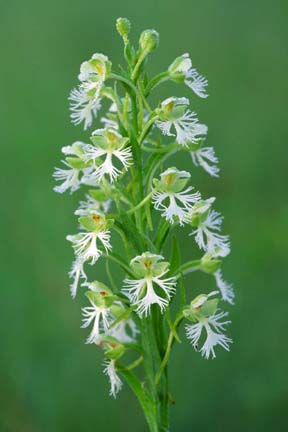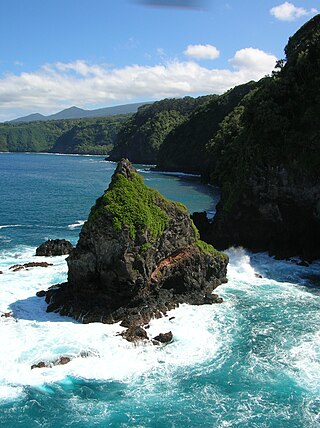Hawaiian hibiscus are seven species of hibiscus native to Hawaii. The yellow hibiscus is Hawaii's state flower. Most commonly grown as ornamental plants in the Hawaiian Islands are the non-native Chinese hibiscus and its numerous hybrids, though the native Hibiscus arnottianus is occasionally planted.

Platanthera leucophaea, commonly known as the prairie white fringed orchid or eastern prairie fringed orchid, is a rare species of orchid native to North America. It is a federally threatened species, protected since October 30, 1989 under the Endangered Species Act of 1973. In Canada, it has been listed endangered under Schedule 1 of the Species at Risk Act since 2005. In 2014, the International Union for Conservation of Nature assessed it as "least concern."

Platanthera yadonii, also known as Yadon's piperia or Yadon's rein orchid, is an endangered orchid endemic to a narrow range of coastal habitat in northern Monterey County, California. In 1998 this plant was designated as an endangered species by the United States government, the major threat to its survival being continuing land development from an expanding human population and associated habitat loss. One of the habitats of Yadon's piperia, the Del Monte Forest near Monterey, California, is the subject of a federal lawsuit, based upon endangerment of this organism along with several other endangered species.

Schenkia sebaeoides, known as ʻĀwiwi in Hawaiian and lavaslope centaury in English, is a rare species of flowering plant. It is endemic to low shrublands in the state of Hawaiʻi in the United States. It is present on the islands of Kauai, Oahu, Lanai, Molokai, and Maui. At the time it was added to the endangered species list of the United States in 1991 it was known from seven populations for a total of fewer than 1000 individuals. It is threatened by habitat loss.

Adenophorus periens is a rare species of fern known by the common name pendant kihi fern. It is endemic to Hawaii, where it is known from one population in Puna on the island of Hawaii and a few occurrences on Kauai and Molokai. The fern occurs in wet mountain forests on volcanic slopes. It grows on trees. There are perhaps 2000 individual plants remaining. This is a federally listed endangered species of the United States.

Cyperus trachysanthos is a rare species of sedge known by the common names pu`uka`a and sticky flatsedge. It is endemic to Hawaii, where it is known from Kauai and Oahu. It was known from Niihau, Molokai and Lanai, but it has been extirpated from these islands. It is a federally listed endangered species of the United States.
Cyrtandra oenobarba is a rare species of flowering plant in the African violet family known by the common name shaggystem cyrtandra. It is endemic to Hawaii, where it is known only from the island of Kauai. It can be found in only three localized areas of the island and there are fewer than 500 individuals remaining in the wild. It was federally listed as an endangered species in 2010. Like other Hawaiian Cyrtandra it is called ha`iwale.

Diplazium molokaiense is a rare species of fern known by the common name Molokai twinsorus fern. It is endemic to Hawaii, where it is one of the rarest ferns. It has historically been found on the islands of Kauai, Oahu, Lanai, Molokai, and Maui, but it is thought to have been extirpated from four of them and today can be found only on Maui where fewer than 70 individual plants remain. The fern was federally listed as an endangered species of the United States in 1994.
Geranium kauaiense is a rare species of geranium known by the common name Kauai geranium. It is endemic to Hawaii, where it is known only from the island of Kauai. It was federally listed as an endangered species in 2010. Like other Hawaiian geraniums, this plant is known as hinahina and nohoanu.

Kadua cookiana is a rare species of flowering plant in the coffee family known by the common names 'awiwi and Cook's bluet. It is endemic to Hawaii, where it is known only from Kauai, having been extirpated from Molokai and Hawaii. It is a federally listed endangered species of the United States.

Ischaemum byrone is a rare species of grass known by the common name Hilo murainagrass or Hilo ischaemum. It is endemic to Hawaii, where it is present on Kauai, Maui, Molokai, and Hawaii. It was known from Oahu but it is now extirpated there. There are perhaps 1000 to 3000 individual plants remaining in total. This is a federally listed endangered species of the United States.

Cyperus pennatiformis is a rare species of sedge known by the common name coastal flatsedge. It is endemic to Hawaii, where it grows on the islands of Maui, Kauai, and Laysan. It is a federally listed endangered species of the United States.

Peucedanum sandwicense is a rare species of flowering plant in the carrot family known by the common name makou. It is endemic to Hawaii, where it is known from Maui, Molokai, Kauai, and Oahu. It is threatened by introduced species of plants and animals. It is a federally listed threatened species of the United States.

Plantago princeps is a rare species of flowering plant in the plantain family known by the common name ale. It is endemic to Hawaii, where it is known from the islands of Hawaii, Kauai, Oahu, Molokai, and Maui. Like other Hawaiian Plantago, it is known as kuahiwi laukahi, or laukahi kuahiwi. It is a federally listed endangered species of the United States.
Schiedea membranacea is a rare species of flowering plant in the family Caryophyllaceae known by the common name valley schiedea. It is endemic to Hawaii, where it is known only from the island of Oahu. It has been extirpated from Maui and Molokai. Plants in a population known from Kauai are actually members of other species. Thus, the species is now endemic to Oahu. It is threatened by the degradation and destruction of its habitat. It is a federally listed endangered species of the United States.

Silene lanceolata is a rare species of flowering plant in the family Caryophyllaceae known by the common names Kauai catchfly and lanceolate catchfly. It is endemic to Hawaii, where it is known only from Oahu, Molokai, and Hawaii, having been extirpated from Kauai and Lanai. It is threatened by the degradation of its habitat and it is a federally listed endangered species of the United States.

Spermolepis hawaiiensis is a rare species of flowering plant in the carrot family known by the common name Hawai'i scaleseed. It is endemic to Hawaii, where it is known from the islands of Kauai, Maui, Oahu, Molokai, Lanai, and Hawaii. It is threatened by the degradation of its habitat and it is a federally listed endangered species.

Solanum incompletum is a rare species of flowering plant in the family Solanaceae known by the common names thorny popolo and popolo ku mai. It is endemic to Hawaii, where it occurs today on the islands of Maui, Lanai, and Hawaii. It is threatened by the destruction and degradation of its habitat. It is a federally listed endangered species of the United States.

Vigna owahuensis is a rare species of flowering plant in the legume family known by the common name Oahu cowpea.

The Hawaiian stilt is an endangered Hawaiian subspecies of the black-necked stilt species. It is a long-legged, slender shorebird with a long, thin beak. Other common names include the Hawaiian black-necked stilt, the aeʻo, the kukuluaeʻo, or it may be referred to as the Hawaiian subspecies of the black-necked stilt.















